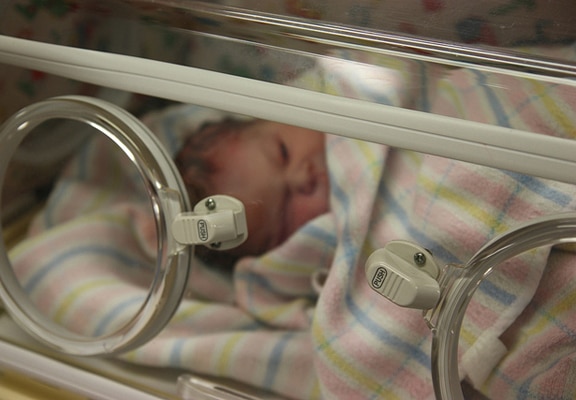

Credit: Ben Tubby on Flickr, under Creative Commons (CC BY-NC 2.0)
NEW YORK (WOMENSENEWS)–In the borough with the city’s highest maternal mortality rate, two women in labor in August died at Jacobi Medical Center, a public hospital in the Bronx, N.Y.
Days later, health authorities closed a highly regarded maternity care center nearby and shifted patients and staff to Jacobi, a decision that has riled health and community activists.
“As a doctor, I know you don’t practice medicine by telling your patients, especially pregnant women, to take a bus to another hospital,” said Frank Proscia, executive director of Doctors Council, which represents doctors working in the hospitals, at a public rally in September.
Giving staff and patients just three days’ notice, North Central Bronx Hospital ended after 36 years its maternity care services on Aug. 12. All of the hospital’s maternity care services, including a prenatal clinic, were transferred to Jacobi Medical Center, a 10-minute-taxi-ride away but at least 50 minutes for those relying on public transportation.
Health care activists, union members and community leaders have held rallies, organized press conferences and pressured local public officials to return maternity services to North Central, known for its quality of maternity care, and to advocate for pregnant women of all economic backgrounds across the city to have access to better health care.
Anthony Feliciano, director of the Commission on the Public’s Health System, said in an email interview that the commission is aiming to catalyze a coalition of community members and labor union members, including parents living in Northwest Bronx, to demand labor and delivery services be reopened at North Central.
“There must be a solution that improves labor and delivery services for the entire North Bronx community that goes beyond hiring more staff,” Feliciano said.
Organizers also are pushing for the midwife model that excelled at North Central to become the standard in maternity care across New York’s hospitals.
With over half of the hospital’s patients on Medicaid or uninsured, North Central was recognized nationally for its high-quality midwifery practice that served many minority, immigrant and low-income women.
In 2002, North Central received the American College of Nurse Midwives‘ award for innovative and compassionate midwifery care practices.
Highest Death Rate
The Bronx–with a population that is 53 percent Hispanic and 43 percent African American, according to Census data–has the highest maternal mortality rate in New York City with a rate of 34 deaths for every 100,000 live births, according to a 2010 report from the city’s health department.
The neighborhood surrounding the North Central hospital had a maternal mortality rate that was less than half of the neighborhood to its north (23 deaths for every 100,000 live births compared with 57.8), according to the city’s 2010 report.
Citywide, in 2011, the most recent statistics available, Hispanic women’s maternal mortality rate was 24 per 100,000 births and black women’s rate was 46.5, according to a report by the New York City Department of Health and Mental Hygiene. That year, the nationwide figure was 21 maternal deaths per 100,000 births.
In 2008, North Central had the lowest Cesarean-section rate–15.9 percent of all births–among all the hospitals in the city. In 2009, however, the hospital’s midwife services were drastically reduced. By 2011, the C-section rate climbed to 25 percent of all births, according to the New York State Department of Health.
The World Health Organization recommends a C-section rate of 15 percent. Cesarean sections increase the risk for embolisms, infection and hemorrhage and thus add to the mother’s risks for death or significant harm.
Health and Hospitals Corporation (HHC), the New York City public hospital system that manages both North Central and Jacobi, stated in the closing notice that by transferring all labor and delivery service to Jacobi alone, where almost 2,000 babies were delivered last year, the agency will “be better able to target resources and ensure optimal staffing to provide the most comprehensive, safe and efficient model of inpatient obstetrical and gynecological care for our patients.”
Increased Safety Risks
Proscia, of the Doctors Council, criticized that decision at a Sept. 4 rally in front of Jacobi. “Instead of addressing safety concerns as they occur, HHC has made a habit of creating emergencies as a way to justify cutting services at the expense of patients,” he told a crowd of dozens.
The decision to send pregnant women who were receiving care through North Central to Jacobi represents an abdication by hospital managers and puts mothers and their babies at even greater–not less–safety risks, Proscia said. “You don’t practice responsible patient care by eliminating services to the most underserved in our communities.”
Community groups say Jacobi’s maternal care services have been plagued by poor management and severe understaffing for years. Mothers have been separated from their babies for several hours and there aren’t enough rooms to accommodate the extra patients.
Jacobi Hospital and the hospital corporation’s press office have not returned calls requesting comment.
“Also problematic,” said Proscia in an email interview, “is the fact that there is a lack of senior experienced doctors in obstetrics and gynecology.” He also expressed concern that Jacobi no longer has a program for residents, the young doctors who are often on call and provide the most direct patient care.
The 100 nurses who were transferred from North Central to Jacobi haven’t had time to adjust, said Jill Furillo, executive director of New York State Nurses, at the rally. “The nurses who came here have not had the appropriate orientation to the situation here. They haven’t had the appropriate training. After one day of orientation they are being given patient assignments. The staffing situation is not good.”


